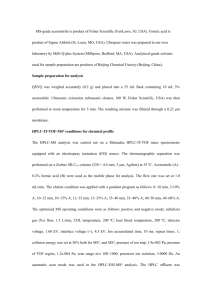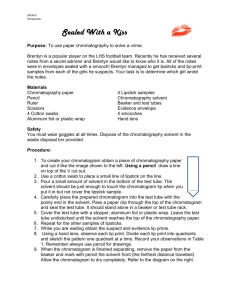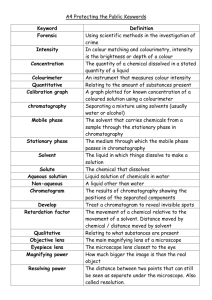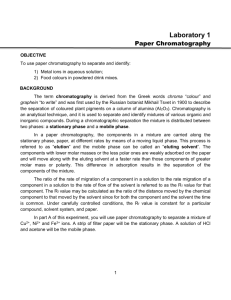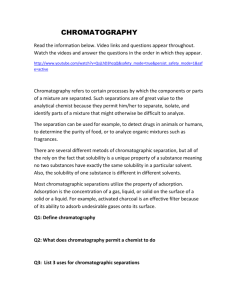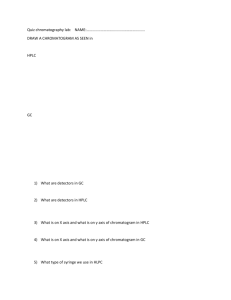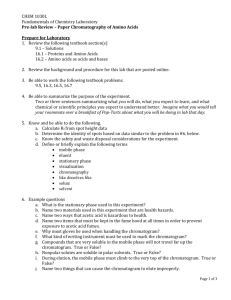Chromatography
advertisement
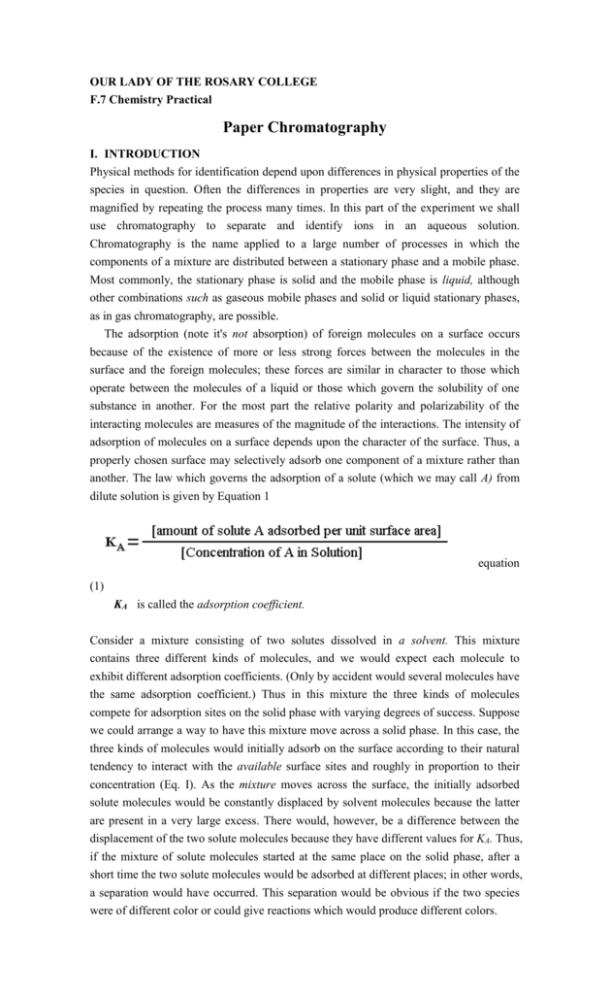
OUR LADY OF THE ROSARY COLLEGE F.7 Chemistry Practical Paper Chromatography I. INTRODUCTION Physical methods for identification depend upon differences in physical properties of the species in question. Often the differences in properties are very slight, and they are magnified by repeating the process many times. In this part of the experiment we shall use chromatography to separate and identify ions in an aqueous solution. Chromatography is the name applied to a large number of processes in which the components of a mixture are distributed between a stationary phase and a mobile phase. Most commonly, the stationary phase is solid and the mobile phase is liquid, although other combinations such as gaseous mobile phases and solid or liquid stationary phases, as in gas chromatography, are possible. The adsorption (note it's not absorption) of foreign molecules on a surface occurs because of the existence of more or less strong forces between the molecules in the surface and the foreign molecules; these forces are similar in character to those which operate between the molecules of a liquid or those which govern the solubility of one substance in another. For the most part the relative polarity and polarizability of the interacting molecules are measures of the magnitude of the interactions. The intensity of adsorption of molecules on a surface depends upon the character of the surface. Thus, a properly chosen surface may selectively adsorb one component of a mixture rather than another. The law which governs the adsorption of a solute (which we may call A) from dilute solution is given by Equation 1 equation (1) KA is called the adsorption coefficient. Consider a mixture consisting of two solutes dissolved in a solvent. This mixture contains three different kinds of molecules, and we would expect each molecule to exhibit different adsorption coefficients. (Only by accident would several molecules have the same adsorption coefficient.) Thus in this mixture the three kinds of molecules compete for adsorption sites on the solid phase with varying degrees of success. Suppose we could arrange a way to have this mixture move across a solid phase. In this case, the three kinds of molecules would initially adsorb on the surface according to their natural tendency to interact with the available surface sites and roughly in proportion to their concentration (Eq. I). As the mixture moves across the surface, the initially adsorbed solute molecules would be constantly displaced by solvent molecules because the latter are present in a very large excess. There would, however, be a difference between the displacement of the two solute molecules because they have different values for KA. Thus, if the mixture of solute molecules started at the same place on the solid phase, after a short time the two solute molecules would be adsorbed at different places; in other words, a separation would have occurred. This separation would be obvious if the two species were of different color or could give reactions which would produce different colors. II. PROCEDURE A very useful and simple method of chromatography, incorporating the ideas described above, is paper chromatography, which employs filter paper as the stationary phase and an appropriate solvent (or solvent mixture) as the liquid phase, which is called the clueing solution. In this part of the experiment we shall use paper chromatography to separate and identify the ions in a mixture of cations. Your unknown will contain one or more of the following cations: Fe3+, Co2+, Cu2+, Mn2+, Ni2+. A. Chromatographic Chamber Assemble the apparatus shown in Figure 1 using a 19150 mm test tube. Straighten a paper clip and push it slowly (CAUTION) but firmly through a cork which firs the test tube The bent paper clip hook will be used to suspend a piece of chromatographic paper in the test tube so that it just touches the eluting solution. B. Preparation of a Micropipette The unknown solution will be placed upon the chromatographic paper using a microppette prepared by drawing a piece of glass tubing to a fine diameter. NOTE: Your laboratory instructor wiIl instruct you in the proper way to draw a piece of glass tubing using a Bunsen burner. The micropipette should look like the object shown in Figure 3. Melting point capillaries can be used as micropipettes if they are available. The drawn end sbould be sufficiently small in diameter to draw liquid into it spontaneously when it is placed in a solution; no drops of liquid should form at the tip when it is removed from solution. C. Preparation of Eluting Solution Obtain 4.5 ml of acetone in a graduated test tube and add sufficient 6 M HCl to bring the total volume of solution to 5 cm3. Pour enough of this solution into a 19 x 150 mm test tube so that the level of solution is about 1 cm from the bottom; stopper this test tube and save it. D. Preparation of the chromatogram Obtain a sample of the unknown in a large, clean, dry test tube, and a strip of chromatographic paper. Figure 2 and 3 Micropeippette can be prepared by drawing a piece of glass tubing to form a long constriction Cutting at the point indicated produces two micropipettes. Figure 4 A piece of chromatographic paper before the unknown is spotted onto it, The unknown is applied a long a tightly penciled line about 1 cm from the bottom of the strip CAUTION: Do not handle the paper with your fingers if either they or the paper or both are wet. With a pencil, draw a light line on one end of the strip of chromatographic paper about 1 cm from, and parallel to, the short dimension (figure 4) . Using your micropipette, place a thin line of unknown solution along the pencil line on the chromatographic paper. When you place the end of your micropipette into the unknown solution, a column of liquid should be drawn up into the pipette. When you touch the tip or the pipette to the dry chromatographic paper, the liquid will be absorbed by the paper and be drawn from the pipette. You should make a few practice trials drawing a straight line with your unknown on ordinary filter paper. E. Elution of the Chromatogram After the chromatogram has dried for a few minutes, catch the end (opposite the unknown end) of the strip of chromatographic paper over the paper clip hook prepared earlier; the paper should hang freely at such a height as to dip into the eluting solution about 0.5 cm when the cork is placed in the test tube containing the previously prepared eluting solution. The apparatus should look like that shown in Figure 5. Figure 5 Eluting the chromatogram. Figure 6 The eluted chromatogram will have several more or less distinct stripes of colours across it. Set the test tube in a vertical position for about 10 minutes or until the line marking the solvent front is near the top of the chromatographic paper strip. F. Preparation of the Development Chamber While the chromatogram is eluting, place about 0.5 ml of 6M NH3 in a 19 x 150 mm test tube and stopper it. Save for future use. G. Marking the Chromatogram When the solvent front has reached almost to the top of the chromatogram remove it from the eluting chamber and mark the position of the solvent front with a pencil. This must be done quickly because the solvent evaporates rapidly. Allow the chromatogram to dry in air; record the positions and color of the bands in your notebook. The chromatogram will generally appear like that shown in Figure 6. II. Development of chromatogram After the chromatogram is dry, attach it to the paper clip book, and hang it in the developing chamber containing NH3. The apparatus at this point should look like that shown in Figure 7. NOTE: The chromatogram should not touch the solution in the bottom of the test tube. The object of the development step is to bathe the chromatogram in NH3 vapors which may cause the formation of complex compounds with characteristic colors. The development should take about 30 seconds Record in your notebook any color changes which may occur in the bands on your chromatogram. Fe(H2O)63+ FeCl3 Co(H2O)62+ CoCl2 CoCl2(NH3)2 Cu(H2O)62+ CuCl2(H2O)2 CuCl2 Cu(NH3)4(H2O)22+ Ni(H2O)62+ NiCl2(H2O)2]2+ Mn(H2O)62+ Mn(H2O)62+ MnCl2 Mn(OH)2 MnO Yellow Yellow Red Blue Rose-red or bluish violet; gray-green when wet Pale blue Green Yellow; pink in acetone Dark blue Green Pale green Purple-violet Pale pink Pale pink Red-brown Red-brown III. DATA ANALYSIS Transition metal ions form coordination compounds which exhibit characteristic colors depending upon the ligands present. The predominating ligands in the eluting solution are Cl- (from HCI) and H20 The development provides a source of NH3 ligands. Thus! it is possible that the transition-metal ions in your unknown may contain either Cl- or H20 ligands or a mixture of these species. When exposed to ammonia the ions may contain mixtures of Cl-, H20, and NH3 as ligands. Table 1 contains a list of the possible complex compounds and the colors of the transition metal ions that may be a part of your unknown. This information, plus your observations on the freshly eluted chromatogram and the developed chromatogram should be sufficient to identify the cations in your un- known. For example, a green band in your chromatogram which turned violet upon exposure to NH3 indicates the presence of nickel. If your interpretation is ambiguous, you can prepare a chromatogram of a solution containing a unknown ion (or an ion you think might be present) and compare the results. I. Rf Valnes The rate at which an ion moves during elution is characteristic of that ion. The rates at which ions move are generally related to the movement of the solvent front A measure of the rate at which anion moves is called its Rf value. Each ion has its own characteristic Rf value in a given solvent using a given paper. The Rf value of an ion is defined by the expression Thus, if an ion moves as rapidly as the solvent front, its Rf value is 1.0; generally, the ions move less rapidly than the solvent and Rf values are less than one. K. Sample Calculation of Rf Values Assume your chromatogram looks like the one shown in Figure 8. Measure (in cm) the farthest distance each ion has traveled from the starling line and the total distance from the starting line to the solvent front. Assume the data are as given in Figure 11.7. Using Equation 2 the Rf values of the ions are calculated as follow. 3 Rf 0 .3 10 5 Rf 0 .5 10 9 Rf 0 .9 10 Figure 8. Measurements to be made on an eluted chromatogram to calculate Rf values for various bands. The report for this experiment consists of naming the ions present in your unknown and calculating their Rf values. Result slip Distance of solvent front travelled = Colour of spot Distance that ion moved Rf value of the Ion presenet ion Questions for discussion 1. In table 1 it is indicated that a possible species in the developed chromatogram is Mn(OH)2. Give balanced equations which explain the presence of this species on the developed chromatogram. 2. Two coloured ions exhibit Rf values of 1.00 and 0.95, respectively, in a given solvent. (a) Give a sketch of what you would expect the chromatogram to look like. (b) Why would chromatography be a poor basis for the identification of these ions? (c) What variables could you attempt to change to improve the basis for identification of these ions?
